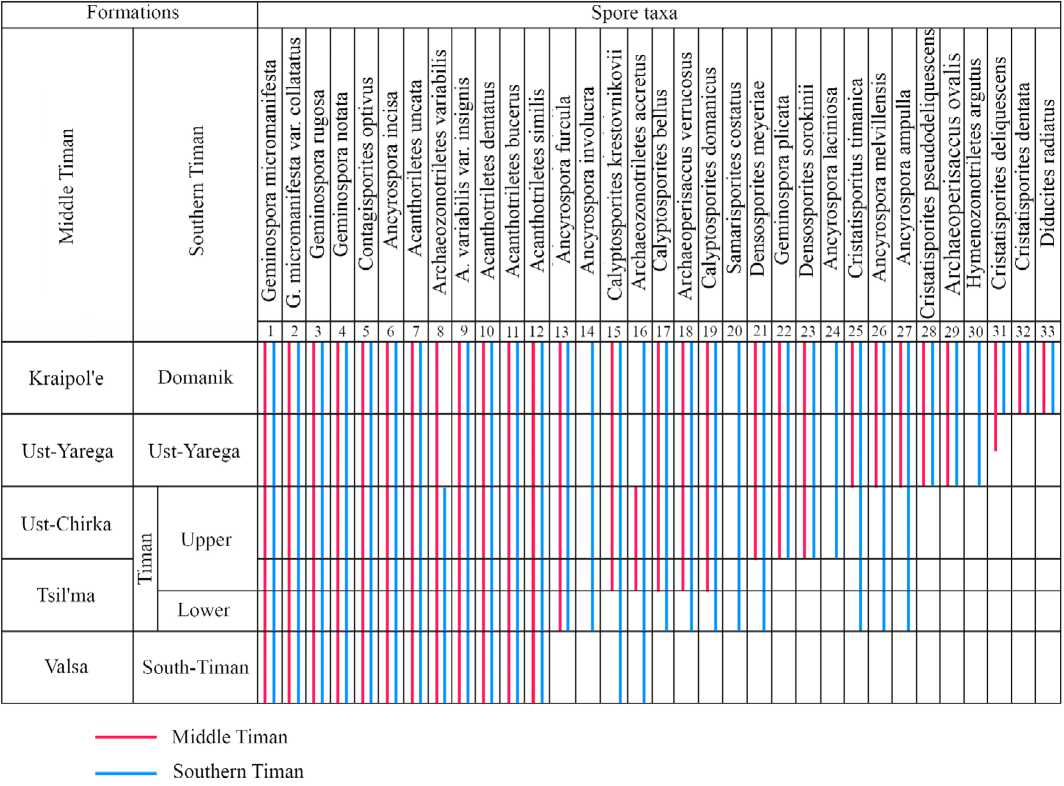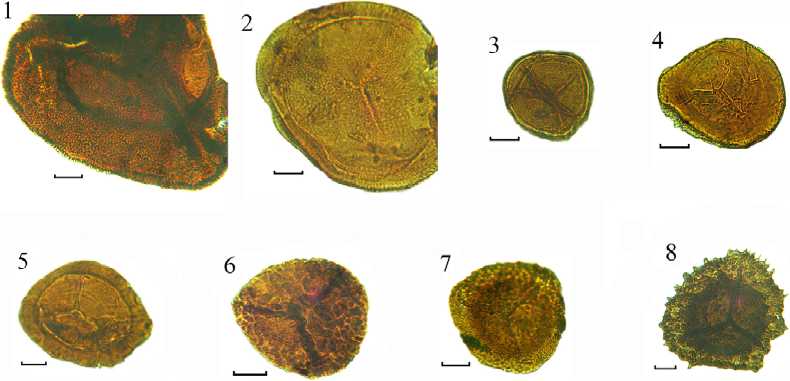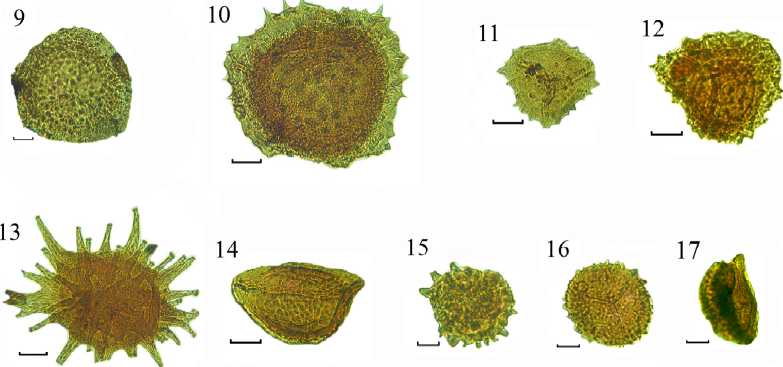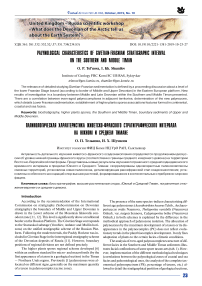Palynological characteristics of givetian-frasnian stratigraphic interval on the Southern and Middle Timan
Автор: Telnova O.P., Shumilov I. Kh.
Журнал: Вестник геонаук @vestnik-geo
Рубрика: Научные статьи
Статья в выпуске: 10 (298), 2019 года.
Бесплатный доступ
The relevance of detailed studying Givetian-Frasnian sedimentation is defined by a proceeding discussion about a level of the lower Frasnian Stage bound (according to border of Middle and Upper Devonian) in the Eastern European platform. New results of investigation in a boundary between Middle and Late Devonian within the Southern and Middle Timan presented. There are a correlation between even-aged palynocomplexes in adjacent territories; determination of the new palynozone, which details Lower Frasnian sedimentation; establishment of higher plants spores associations features formed in continental, coastal and sea facies.
Biostratigraphy, higher plants spores, the southern and middle timan, boundary sediments of upper and middle devonian
Короткий адрес: https://sciup.org/149129346
IDR: 149129346 | УДК: 561: | DOI: 10.19110/2221-1381-2019-10-23-27
Текст научной статьи Palynological characteristics of givetian-frasnian stratigraphic interval on the Southern and Middle Timan
According to the recommendation of the International Commission on stratigraphy (Subcommission on Devonian stratigraphy) the boundary of Middle and Upper Devonian is drawn in the Lower subzone of the Mesotaxis falsiovalis conodont zone [11, 12]. This level is significantly above a traditional border on the Russian Platform. The Givetian Stage corresponds to the Starooskol substage (Vorobiev, Ardatov and Mullin horizons) on the unified stratigraphic scheme of the Russian Platform. Following the modern trends, the Pashiy Horizon was included in Givetian Stage in the interregional stratigraphy scheme of the Devonian deposits of Russia [11]. However, boundary positions of regional divisions are not defined precisely.
The higher plants spores regional scheme developed [6] within an uniform standard for micro- and macrofossils (by the first appearance of a taxon in a geological section) in the Timan — Northern Urals region. Previously [1] palynozones were allocated on different signs, generally on the maximum quantity of a taxon in palynocomplex (acme zone).
The presence of the same species-indices characterizing different age palynozones ( Acanthotriletes bucerus Tchib., Archaeo-perisaccus ovalis Naumova, Tholisporites variabilis (Naumova) Oshurk. var . insignis Sennova , Calyptosporites bellus (Naumova) Oshurk.) in both schemes is explained by the difference in the methodical approach of palynozone isolation. The allocation of palynozones by the maximum development of a taxon or its disappearance in the palynocomplex (PC) does not reflect evolutionary trends in the plant biocomplex development. It only fixes adaptation of plants to the certain facies-climatic conditions.
The analysis of even-aged palynocomplexes structure of different facies in the Southern and Middle Timan sediments illustrates facial confinedness of some spore taxons sets (tab. 1). However, implementation of the different methodological techniques (correlations between the palynological zones of coastal and sea facies and paleontological ones, the analysis of the complete taxonomical palynospectrum (PS), percentage of taxons, etc.) allowed to detail the stratigraphical partition of geological sections,
Table 1. Stratigraphic ranking of the most important spores taxa studied in the Givetian-Frasnian sediments of the Middle and Southern Timan
Табёица 1. Стратиграфическое ранжирование наиболее важных таксонов спор, изученных в живетско-франских отложениях на Среднем и Южном Тимане

to allocate a new palynozone and to carry out regional and interregional correlations. It established that the bottom of Ust-Yare-ga Formation is characterized by a palynozone of Cristatisporites pseudodeliqucsens-Archaeoperisaccus ovalis , and the top — by Cris-tatisporites deliqucsens (tab. 2).
Taking into account the new data about the higher plant spores in the Northern Timan Urals region, authors explore variants of phytostratigraphic boundary level that would be the closest to the modern level of the discussed border.
The history of studies of the regional stratigraphic boundary is not covered in this article as it already has been repeatedly described in other publications [2, 3, 6, 8].
Palynostratigraphy and paleoreconstructions
Russian palynologists traditionally correlated Pashiy-Sar-gaevo stratigraphic interval with optivuskrestovnikovii palyno-zone (tab. 2) [1]. Its lower bound approximately corresponds to the base of the hermanni-cristatus conodonta zone.
In the Timan — Northern Urals region the optivus-kre-stovnikovii zone expands on the Yaransk, Dzher, Timan, Sar-gaevo horizons [2]. O. P. Telnova [6] allocated regional palyno-zones in the stratigraphic volume of this zone on the Southern Timan and called with names of the first time encountered spores (tab. 2). This scheme has been corrected and expanded with analysis results of the PS from the Middle Timan geological sections [7].
The Middle Timan PC correlate well with ones in stratotype sections in the Southern Timan (stratotypes of Timan and Ust-Yarega Formations), in the Pechora Sineclise (the Dzher Horizon), in more remote sections on the Chernyshev’s Ridge and in the Main Devonian Field.
The general trend in a change of taxonomical structure of PS is observed in the Givetian-Frasnian stratigraphic interval in the compared territories. Spores of a genus Geminospora dominate in all PS (producers — Archeopteris plants, Archae-opteridales order). In the Devonian time only Archeopteris got a wooden habitus. Well-developed root system allowed them to grow on high landscape sites, all other plants tied to water basins. Thus, Archeopteris avoided fierce competition and quickly created a dominating group of plants in the Middle and Upper Devonian floristic communities. Cosmopolitan distribution and wide age range make spores of these plants inert for the stratigraphic constructions. Therefore, the emphasis is placed on spores of subdominant groups in the analysis of PS.
Five PC were established in Valsa, Tsilma, Ust-Chirka, Ust-Yarega and Kraypole Formations on the Middle Timan (tab. 2). On the Southern Timan in Valsa PSs as well as in the Upper
Table 2. The chart of comparison palinozone optivus-krestovnikovii of the East-European Platform
Таблица 2. Схема сопоставления палинозоны optivus-krestovnikovii на Восточно-Европейской платформе
|
East European Platform (after Avkhimovitch et al., 1993) |
Southern Tinian |
Middle Timan |
||
|
Subzone |
Zone |
Palynozone |
Formation |
Formation |
|
S. bellus |
A. ovalis — V. grumosus |
Dominant phytoplankon |
Domanik |
Kraipol’e |
|
G. semilucensis — P. donensis |
G. semilucensis — P. donensis |
|||
|
A. bucerus — A. variabilis insignis |
C. optivus — S. krestovnikovii |
C. deliquesens C. pseudodeliquesens — A. ovalis |
Ust’-Yarega |
Ust’-Yarega |
|
D. sorokinii |
Timan |
Ust’-Chirka |
||
|
P. vermiculatus — C. domanicus |
Tsil’ma |
|||
|
A. incise — G. micromanifesta |
C. bellus — D. meyeriae |
|||
|
A. bucerus — A. variabilis insignis A. accretes |
Southern Timan |
Valsa |
||
Chibj Formation small (20—40 µ ) spores with small-spicular sculpture of exine ( Acanthotriletes bucerus, A. eximius Naumova , A. similis Naumova et al.) formed the subdominant group. The spores and pollen size reduction and the small-spicular sculpture of the recent spores connected with deterioration in facies-climatic conditions of their producers growth [4]. It is possible to assume by analogy that increase in quantity and variety of spores of the Acanthotriletes group could indicate some aridization and, perhaps, a small cold snap in this period. In this time tectonic and volcanic activity increased in the all Ti-man territory.
The increase in numbers (up to 25 %) and diversity of spores in PCs of Tsilma, Ust-Yarega, Krypole Formations on the Middle Timan and Timan, Ust-Yarega Formations on the South Timan with a wide thin zone ( Calyptosporites, Densos-porites, Hymenozonotriletes , etc.) may indicate a climatic trend towards humidity. Producers of the spores were ferric and placid plants [6]. It correlates with the regional manifestation of the Frasne event (global transgression) recorded in many regions of the world.
Taxonomic composition of PC from sections of the Middle Timan differs from such on the Southern Timan by percentage content, absence of some taxa, including index species ( Perotrilites vermiculatus Med. ) and by different stratigraphic range in rare cases. For example, spores Archaeozo-notriletes variabilis, A. variabilis var. insignis were listed as dominant and guiding species for the Sargaevo Horizon for the long time [1, 2]. Later, different compositions of PC were established in different areas of the Timan in deposits of Sar-gaevo age [2, 6]. These forms are rare and sometimes absent in the Ust-Yarega Formation of the Sargaevo Horizon in the Tsilma River basin.
Minor differences in taxonomic composition of PCs from single-age deposits of the Middle and the Southern Timan are explained by landscape-facial conditions of their producers growth. The constant lowering of the Southern Timan territory was the cause of constant watercourses and various water areas facies of warm humid climate. The Middle Timan slow dive and some elevation of this territory led to the spread of periodically changing facies from drier to wetter and vice versa. The lithological analysis results show a high sedimental variability of most formations on the Middle Timan both in section and in extension, which is typical of alluvial coastal plains.
For the first time the appearance of taxa spores Cris-tatisporites pseudodeliquescens Telnova et Marshall , Archaeo-perisaccus ovalis Naumova was traced in the sections of the Ust-Yarega Formation of the Southern Timan. The palynozone Cris-tatisporites pseudodeliquescens [6] was established here. Later, the simultaneous appearance of these taxa was traced at the single-age stratigraphic level in outcrops of the Darshor Creek on the Chernyshev Ridge on the Middle Timan [5, 7]. This allows adding the binary name of palynozone C. pseudodeliquescens — A. ovalis to the regional spore scheme (tab. 2).
Stratigraphic sequence of appearance of taxa Cristatisporites pseudodeliquescens and Cristatisporites deliquescens (Naumova) Arkh . is traced in the sections of Ust-Jarega Formation on the Middle Timan. The C. deliquescens spores in stratigraphically complete and more shallow-water sections on the Middle Ti-man are highlighted as index species of miosporous sub-complex B of the Cristatisporites pseudodeliquescens zone [7].
In addition, a simultaneous appearance of spores Cris-tatisporites deliquescens and conodonts Ancyrodella rotundilo-ba soluta Sandb . Ziegl. et Bult recorded in section of shallow water-shelf facies in outcrops of the Shera Creek on the Je-jimparma Plato of the Southern Timan (Telnova, Soboleva, Sobolev, in print). The same association of miospores and conodonts was explored in the upper part of the Kedzydshor Formation in outcrops of the Dershor Creek (Chernyshev Ridge) [5, 10].
Conclusion
Thus, the stratigraphic sequence of appearance of taxa Cristatisporites pseudodeliquescens and Cristatisporites deliquescens and an association of conodonts Ancyrodella rotundiloba soluta and the spore Cristatisporites deliquescens found in different areas of the Timan-North Ural region. It allows to identify a new regional spore zone Cristatisporites deliquescens (tab. 2). In the regional Devonian palynostratigraphic zonality scheme [6] the new zone occupies a level between the palynozones C. pseudodel-iquescens and G. semilucensis — P. donensis.
By the present moment, only one stratigraphic level has been correlated on spores and conodonts (orthostratigraphic group of fauna) and it is much higher than the modern boundary of the Middle — Late Devonian. Because of this only phy-tostratigraphic boundaries can be characterized with spores.
Analysis of taxonomic composition of PCs from border deposits shows that the most significant changes occur in the third PC (palynozonne Densosporites sorokinii ) of the Timan Formation on the Southern Timan and in the Ust-Chirka Formation on Middle Timan [7]. In these PCs the taxonomic composition updates on the species and generic levels. Spores of Archeopteris plants ( Contagisporites optivus, Gemi-nospora rugosa, G. notata , G. micromanifesta , etc.) are the main
(up to 50 %) dominant group still. Spores with film perispores ( Calyptosporites, Cristatisporites, Hymenozonotriletes, Densos-porites , etc.) becomes a subdominant group (up to 16 %), which are among the dominant genera higher in section. This level can be considered as a phytostratigraphic frontier. It is a bit lower than Givetian — Frasnian boundary marked by conodonts. Apparently, the trigger for significant changes in both plant and marine communities was the eustatic Frasne event. This event is characterized by the beginning of global transgression and is timed to the foundation of the Early fal-siovalis conodont zone [13]. Regional responses of continental and marine biota components to environmental changes may occur at different rates. Plant biota proved to be more sensitive and responded to climate change almost immediately. In this case, the biotic event almost coincides with the abiotic event.


The most important taxa of spores studied in the Givetian-Frasnian sediments of the Middle and Southern Timan Наиболее важные таксоны спор из живетско-франских отложений на Среднем и Южном Тимане
1 — Contagisporites optivus (Tchib.) Owens, sample 305-1; 2 — Geminospora micromanifesta (Naumova) Owens, sample 317-1; 3 — Geminospo-ra notata (Naumova) Obukh., sample 150-1; 4 — Tholisporites variabilis (Naumova) Oshurk., sample 193-2; 5 — Tholisporites variabilis (Naumova) Oshurk. var . insignis Sen., sample 150-2; 6 — Archaeozonotriletes accretus Tchib., sample Ð2-3; 7 — Calyptosporites bellus (Naumova) Oshurk., sample 417-2; 8 — Calyptosporites domanicus (Naumova) Oshurk., sample ð2-1; 9 — Calyptosporites krestovnikovii (Naumova) Oshurk., sample 193-1; 10 — Densosporites sorokinii Obukh., sample 127-1; 11 — Cristatisporites pseudodeliquescens Telnova et Marshall, sample 127-1; 12 — Cristatisporites deliquescens (Naumova) Arkh., sample 127-1; 13 — Ancyrospora furcula Owens, sample 127-2; 14 — Archaeoperisaccus verrucosus Pashk., sample 317-1;.15 — Acanthotriletes bucerus Tchib., sample 193-1; 16 — Acanthotriletes eximius Naumova, sample 315-1;
17 — Archaeoperisaccus ovalis Naumova, sample 315-1.
The numbers of spore preparations correspond to the numbers of the samples [8]. Scale bar 10 µ m
Íîìåðà ïàëèíîëîãè÷åñêèõ ïðåïàðàòîâ ñîîòâåòñòâóþò íîìåðàì îáðàçöîâ [8]. Äëèíà ìàñøòàáíîé ëèíåéêè 10 µ m
Список литературы Palynological characteristics of givetian-frasnian stratigraphic interval on the Southern and Middle Timan
- Avkhimovich, V. I., Tchibrikova, E. V., Obukhovskaya, T. G., et al. Middle and Upper Devonian miospore zonation of Eastern Europe. Bull. Cent. Rech. Explor.-Prod. Elf-Aquita-ine, 1993, V. 17, No. 1, pp. 79-147.
- Menner, V. Vl., Larionova, Z. V., Araslanova, R. M., and Tsaplin A. E. Novye regional'nye gorizonty nizhnefranskogo pod'yarusa v Timano-Pechorskoi provintsii (New regional horizons of the Lower Frasnian substage in the Timan-Pechora Province), in Palinologicheskii metod v prakticheskoi stratigrafii (Palynology in Practical Stratigraphy), Moscow: Inst. Geol. Razrab. Goryuch. Iskop., 1989, pp. 4-14.
- Ovnatanova, N. S. and Kononova, L. I. Frasnian conodonts from the Eastern Russian Platform, Paleontol. J., 2008, vol. 42, No. 10, pp. 997-1166.
- Sladkov, A. N. Vvedenie v sporovo-pyltsevoi analiz (Introduction into Spore-Pollen Analysis), Moscow: Nauka, 1967, 234 pp.
- Telnova, O. P. Palinologicheskaya harakteristika franskih otlozhenii na ruch'e Dershor (gryada Chernysheva) (Palynological characteristics of Frasnian deposits on the Dershor Creek (Chernyshev Ridge)). Syktyvkar paleontological miscellany 4. (Tr. IG Komi SC UrO RAN 102), Syktyvkar, 2000, pp. 63-68.


